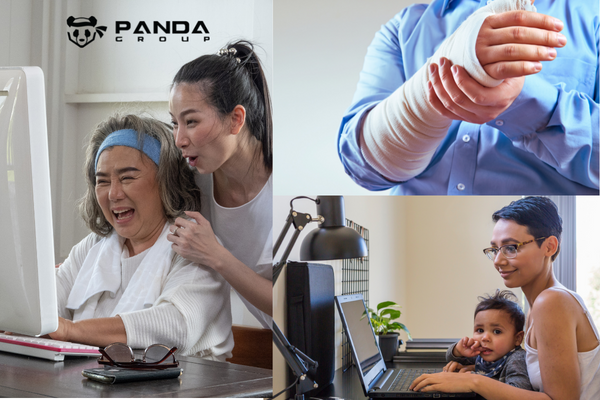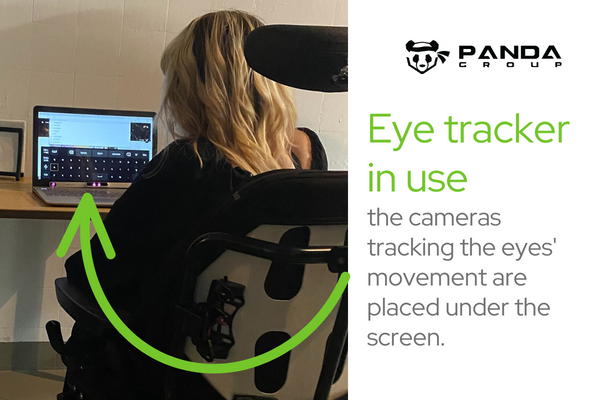Last week we participated in the Poznań Accessibility Meet-up. It was the second event in this edition. We had the opportunity to listen to three speakers:
- Katarzyna Łuszczak from Atabi Eye presented the Eye tracker as an assistive technology for people with mobility disabilities.
- Tomasz Grabowski – is an IT and accessibility specialist, as well as a great person with personal experience of over 30 years in the field of assistive technology.
- Łukasz Garczewski – Communication and Agile Project Management Specialist, Consultant, and Trainer.
Thank you Snowdog for your hospitality!

Augmentative and Alternative Communication
People with mobility dissabilities and those who do not speak or speak unclearly need assistive technologies to communicate and use digital devices to make their lives better and enable them to function normally in society.
It was strongly pointed out that communication ability gives disabilities dignity and a sense of strength, which is crucial for all of us. There is AAC (Augmentative and Alternative Communication) to support people who do not speak or speak unclearly.

We should recognise assistive technology from a wider perspective. Also, people who are temporarily not able to use their usual abilities to operate computers or other digital devices can use assistive technology to provide normal functionality e.g. with a broken arm while recovering.
The eye tracker as an assistive technology
The eye tracker is an assistive technology enabling people with mobility disabilities to communicate and use digital technologies. It’s addressed, for example, to people suffering from neurodegradative diseases that immobilise the limbs and the speech apparatus and do not affect cognitive functions.
Eye tracking is an assistive technology that allows users to control various computer functions using their eyes. While initially designed for people with disabilities, eye tracking has also been used in marketing and advertising to study consumer behaviour.
Eye tracking applications
Eye tracking can be used to determine where a person is looking when viewing an advertisement, product, web page or application. This information can then be used to improve the design of the ad or product.
In addition, eye tracking can be used to monitor a person’s eye movement in order to provide them with assistance. For example, eye tracking can help a person with a reading by identifying words they are having difficulty fixating on.
Eye tracking is used in video games to make the user’s actions faster. Ultimately, eye tracking is a versatile technology that has a wide range of potential applications.
Eye tracking in practice
We had the opportunity to try how it works in practice. The tool can be easily applied to all electronic devices. It’s placed under the screen to allow cameras to track eye movement. Usually there are2 or 3 cameras that need to see the pupil of the eye to operate correctly.

Long eyelashes, a sparkling surface or dilated pupils can disturb its work. Operating a computer with eye tracker support may need some time to be effective. To click you need to stop and focus on the place you want to launch. As with all devices, you may need time to learn and train.
An eye tracker is a tool enabling people to communicate in various ways one of them is an artistic expression. It allows people to paint using eye movement. Sarah Ezekiel is a well-known artist painting with her eyes thanks to assistive technology.
A true story of Assistive Technologies presented by Tomasz Grabowski
A great example of assistive technology usage was presented by Tomasz Grabowski. Hi is an accessibility specialist and self-experiencing technology support during his whole life with childhood cerebral palsy.
He appeared to be a great stand upper who uses technology to express himself with an important message to the rest population, bearing witness to the importance of accessibility for people with disabilities.
He has a YouTube channel and shows his journey with the help of technology from Google’s accessibility settings, to his cane-enabled keyboard and its modern version SmartNav, to his PC Eye tracker.
Special Needs User Experience
Last, but not least, part focused on the user experience with the Uber Application. Łukasz Garczewski recently became a member of the Polish Government Council for Auxiliary and Alternative Communications and easy-to-read and understand the text.
He presented real-life experiences of cab accessibility and urban services. He used the examples of Uber and Poznań city solutions and their shortcomings experienced by people with mobility disabilities.
This part was mind-opening and presented a precise real user point of view, which is not always obvious for digital and urban services designers. And it showed how much more we can do in user experience design and software testing to cover a wider perspective of various needs present in society.


 (No Ratings Yet)
(No Ratings Yet)